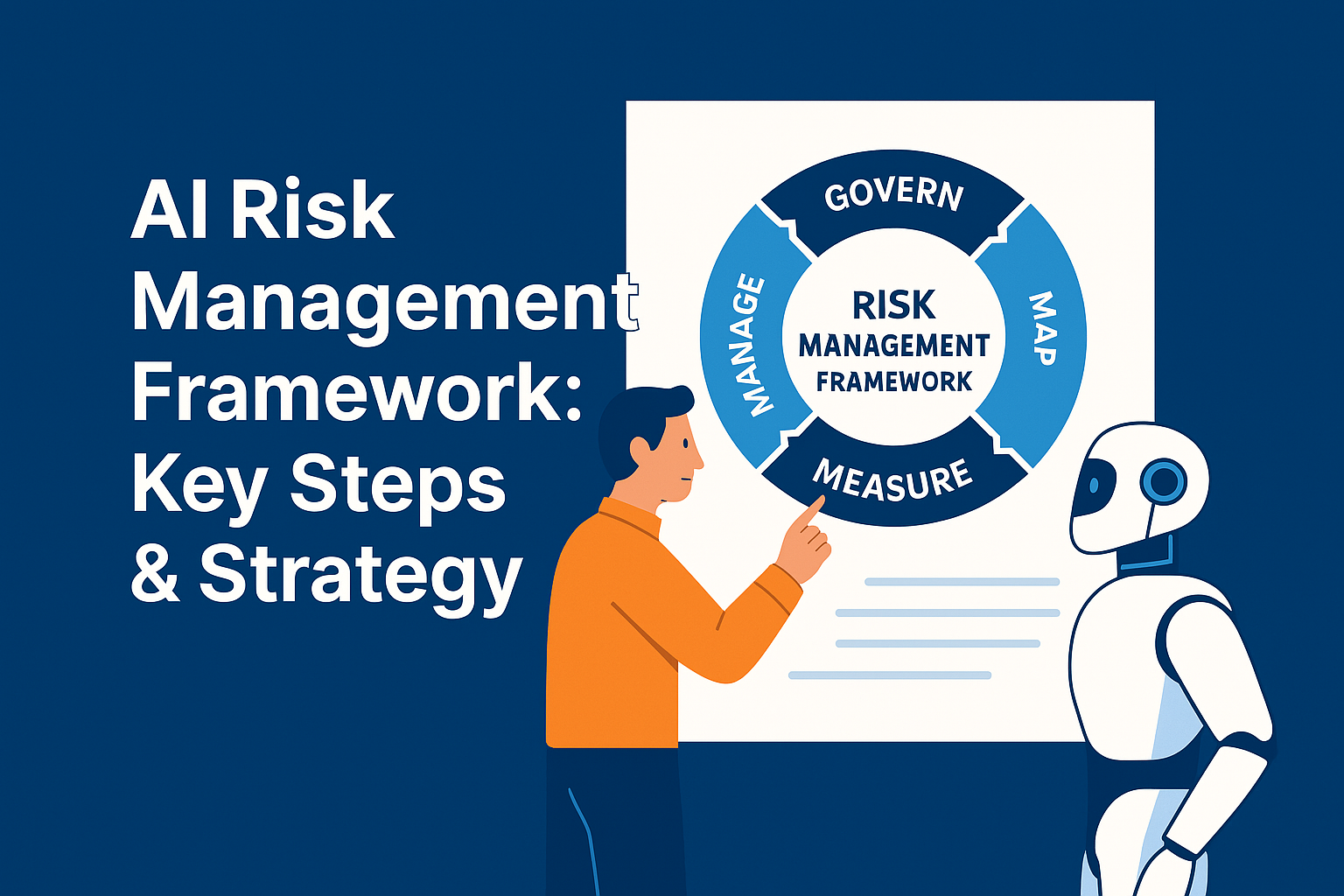AI Risk Management Framework: Key Steps & Strategy
As AI adoption scales across industries, the need for structured risk oversight is no longer optional—it’s critical. Enterprises are deploying AI...
Learn how to manage AI risks with NIST’s AI Risk Management Framework. Ensure trustworthy and responsible AI deployment.
Artificial Intelligence (AI) is offering unprecedented opportunities for innovation, efficiency, and growth. However, along with these benefits come significant risks that can impact individuals, organizations, and society. To address these concerns, the National Institute of Standards and Technology (NIST) developed the AI Risk Management Framework (AI RMF), a comprehensive guide designed to help organizations manage AI-related risks while fostering the responsible development and deployment of AI systems. This blog will provide an in-depth look at the NIST AI Risk Management Framework, its key components, and why it’s essential for businesses and organizations.
The AI Risk Management Framework (AI RMF) is a voluntary set of guidelines developed by NIST to help organizations identify, assess, and mitigate risks associated with AI technologies. Released on January 26, 2023, the framework is built on the principles of trustworthiness, transparency, and accountability, aiming to promote responsible AI use across various sectors. The AI RMF is adaptable, allowing organizations to tailor it to their specific needs, regardless of size or industry.
AI systems can make or break an organization's reputation, legal standing, and overall operational success. Poorly managed AI risks can lead to biased outcomes, security vulnerabilities, privacy breaches, and a loss of trust among stakeholders. Effective AI risk management helps ensure that AI technologies are used responsibly, safely, and ethically, ultimately contributing to better decision-making and reduced liability.
Key concerns addressed by the AI RMF include:
Bias and Fairness: AI models can inadvertently perpetuate biases, leading to unfair outcomes. The AI RMF emphasizes evaluating AI systems for fairness and mitigating biases that could harm individuals or groups.
Transparency: Understanding how AI systems make decisions is crucial. The AI RMF encourages the development of transparent models that allow stakeholders to understand AI processes and outcomes.
Privacy and Security: AI systems often handle sensitive data, making them targets for cyberattacks. The AI RMF outlines strategies to protect data privacy and enhance security measures within AI applications.
Accountability).: Defining clear responsibilities for AI outcomes ensures that organizations can respond effectively to failures or errors in AI systems. The AI RMF helps establish accountability structures within AI workflows.
The AI RMF is structured around four core functions: Govern, Map, Measure, and Manage. Each function serves as a critical pillar in the overall risk management process, helping organizations build robust and resilient AI systems.
Govern: Establishing Governance Structures
The Governance function is the foundation of AI risk management. It focuses on setting up structures, policies, and roles to oversee AI risk management activities. Organizations are encouraged to define responsibilities, create accountability measures, and ensure compliance with legal and ethical standards. Governance also involves establishing communication channels to keep stakeholders informed about AI risks and risk management efforts.
Key actions under this function include:
Map: Identifying and Understanding AI Risks
The Mapping function involves identifying and analyzing the risks associated with specific AI systems. This process includes understanding how AI technologies interact with users and the environment, as well as recognizing potential impacts on stakeholders. The Mapping function emphasizes thorough risk assessments to identify vulnerabilities and areas that require attention.
Key actions include:
Measure: Evaluating AI Risks and Performance
The Measure function focuses on evaluating AI systems against established benchmarks and standards to ensure they meet risk management goals. This function includes monitoring AI performance, assessing risks in real time, and making necessary adjustments to maintain system integrity. Measurement is crucial for validating the effectiveness of risk management strategies and identifying areas for improvement.
Key actions include:
Manage: Mitigating and Controlling AI Risks
The Manage function is the final step in the AI risk management process, where organizations implement actions to mitigate identified risks. This includes developing response plans, integrating risk controls into AI workflows, and continuously refining management strategies based on feedback and performance data.
Key actions include:
Implementing the AI RMF involves a systematic approach tailored to the unique needs of each organization. Here are steps to effectively integrate the framework into your AI risk management strategy:
Assess Your Current AI Systems: Begin by evaluating your existing AI systems and identifying areas where risks are most prominent. This will help prioritize actions and allocate resources effectively.
Engage Stakeholders: AI risk management is not just an IT issue—it affects the entire organization. Involve stakeholders from different departments to gain diverse perspectives on potential risks and mitigation strategies.
Develop a Risk Management Plan: Use the AI RMF to develop a comprehensive risk management plan that includes governance, risk mapping, measurement, and mitigation strategies.
Monitor and Adapt: AI risk management is an ongoing process. Continuously monitor your AI systems, update your risk management plan as needed, and adapt to changes in the AI landscape.
Leverage Tools and Resources: Utilize tools like the NIST AI RMF Playbook, which provides actionable guidance and examples to help implement the framework effectively. The Playbook offers best practices, suggested actions, and references that can be customized to suit specific use cases.
The NIST AI Risk Management Framework is an essential tool for organizations looking to navigate the complex landscape of AI risks. By adopting the framework’s principles of governance, mapping, measuring, and managing, businesses can build more trustworthy, transparent, and accountable AI systems. As AI continues to evolve, proactive risk management will be key to leveraging AI’s potential while safeguarding against its pitfalls. Implementing the AI RMF not only protects your organization but also contributes to the broader goal of responsible AI development that benefits society as a whole.
For more information on how to implement the AI Risk Management Framework, visit the official NIST AI RMF page.
By understanding and applying the NIST AI RMF, organizations can effectively manage AI risks and ensure that their AI initiatives are safe, ethical, and aligned with their strategic objectives.

As AI adoption scales across industries, the need for structured risk oversight is no longer optional—it’s critical. Enterprises are deploying AI...

Are you confident that your company has a complete grasp of the AI tools and technologies being used within its walls? The reality might surprise...

AI marketing campaign management is transforming how businesses approach their digital marketing strategies. By leveraging advanced AI technologies,...
Start your journey with Integrail

Try AI Studio by Integrail FREE and start building AI applications without coding.

NEW White Paper: Discover how AI Studio accelerates your workflows